#cavalry vs infantry
Text
Heavy cavalry vs infantry
Heavy Cavalry vs Infantry: Impact of Cavalry Charge
View On WordPress
0 notes
Note
Recently read your post about each of the kingdom's fighting style and you said the Ironborn had outdated shield wall techniques. So I guess my question is, what makes it outdated, and is there a difference from an ancient Greek Hoplite phalanx vs a Norman shield wall?
So the issue with the Ironborn relying on shield walls - a military strategy that was characteristic of the Early Midde Ages - is that they are almost entirely made up of melee infantry (mostly spearmen and axemen) and have relatively few archers and no cavalry. The rest of Westeros have moved on to a Late Medieval paradigm of warfare that stresses a combined arms approach which relies on a mix of knightly cavalry, more advanced melee infantry (men-at-arms, pikemen, etc.), and archers who work in concert, with melee infantry protecting archers from cavalry, archers targeting blocks of infantry, and cavalry attempting to break enemy infantry often by attacking from the flanks or rear.
A Vikinger-style shieldwall is extremely vulnerable to this Late Medieval army. For one thing, we know that Ironborn don't have the discipline to hold the shieldwall together in the face of a cavalry charge - and when infantry formations break, they can be utterly destroyed as happened at the Battle of Hastings. Moreover, even if the Ironborn could hold their formation, the mere presence of cavalry means they have to stretch their lines to protect their flanks and rear, which means they then have a much thinner line with which to oppose the enemy's infantry.
Likewise, if an army made up entirely of melee infantry shieldwalls come up against large numbers of archers who are supported by knights and/or infantry, they can be absolutely decimated as the archers easily target their slow-moving tightly-packed formations who can't retaliate out of fear of counter-attack from the cavalry, as happened at the Battle of Falkirk.
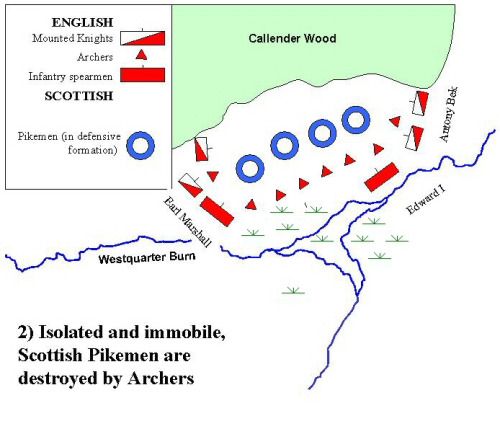
As to the difference between shieldwalls and phalanxes, I answered that question here.
#asoiaf#asoiaf meta#ironborn#shield wall#military history#vikings#early middle ages#late middle ages
52 notes
·
View notes
Photo


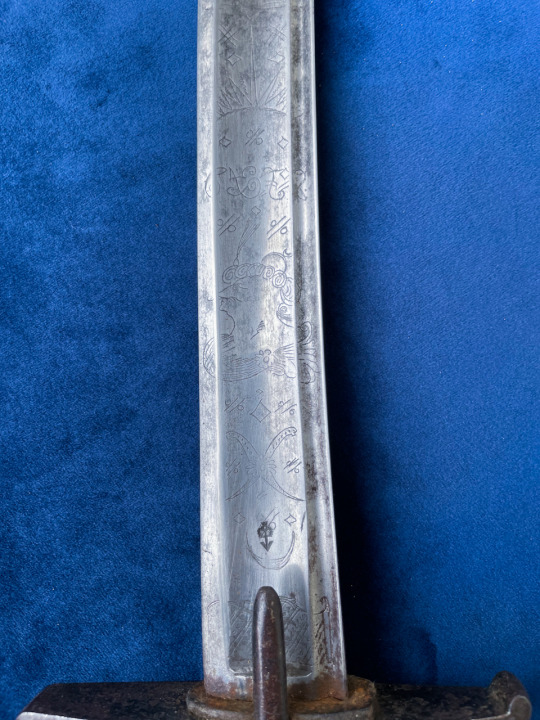




British 1788 Pattern Light Cavalry Trooper’s Sabre.
Prior to 1788, there was no standard pattern of cavalry sword for the British army. Instead, each regiment’s colonel was allotted an annual payment from which he was expected to supply the clothing and equipment for the men. This resulted in each regiment having, essentially their own uniforms and pattern of sword.
In November 1787 the Adjutant General wrote to the commanding officer of each light dragoons regiment asking them to send his office with an example of their regimental trooper sword. A board of General Officers was convened in March of the following year to examine each sword and decide on a standard pattern. Furthermore, they debated the merits of sword vs sabre and British vs German made blades (which were seen to be of superior quality).
On 16th June 1788 they released their decision, one that was almost as vague as the 1786 pattern for Infantry officers:
‘The Hilts to be of the same form as those now used by the Light Dragoons - and to be Five Inches Long in the Grip’
Regarding the blade, they specified:
‘The Blades to be Thirty-Six Inches long - and the Curve in the Centre to be One Inch and three Quarters from the straight line - The Breadth to be One Inch and One Half at the Shoulder - The Blade to be three Eights of an Inch thick and to finish about Eleven Inches from the Point.’
The new pattern swords would be procured by the Board of Ordnance to a sealed pattern for makers to work from. But in practice a lot of variation remains in surviving examples.
This sword is of the type typically manufactured in Solingen and imported by J J Runkel and marked with a ‘crown over arrow’ Ordnance Board inspection stamp. Although this is a troopers’ sabre, the blade shows various Eastern / talismanic decorations that were in fashion during the late 18th Century. The scabbard and grip retain its’ original back paint. While the grip is made from a wood core wrapped in cord and covered in leather.
Source: The British Cavalry Sword 1788 - 1912 by Richard Dellar Ch.1
Overall Length: 1045 mm
Blade Length: 900 mm
Grip Length: 130 mm
Inside Grip Length: 105 mm
Sword Weight: 820 grams
Total Weight: 1,700 grams
Point of Balance: 190 mm
Curve: 51 mm
#Sword#Sabre#Light Cavalry#British Army#1788 Pattern Light Cavalry Sabre#Napoleonic wars#Georgian Era#Cavalry#antiques#Richard Dellar
149 notes
·
View notes
Text
Clash of FE Classes Opening Round - Match 7
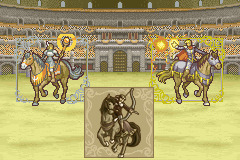
(pictured: a Troubadour icon from Sacred Stones, a Mage Knight icon from Sacred Stones, and a Horseman icon from Shadow Dragon, on a GBAFE arena background)
introductions to the classes, other closely associated classes, and explanations under the cut
Troubadours are typically cavalry units who carry healing staves. they promote into Valkyries, which usually nets them access to offensive magic, although it's not unheard of for them to pick up swords instead. good mobility tends to make them naturally better for utility purposes than infantry Clerics, but there's usually a catch somewhere, such as lower Magic (which can mean less efficient healing and/or less prospects for utilizing offensive staves like Silence and Sleep) or, at the promoted level, weaker overall combat. Troubadours and Valkyries are almost always female, with Fates again bringing the rare exceptions (and still having a gnc femboy as one of them); this is in spite of the fact that "troubadour" is a masculine word, with the feminine being "trobairitz" (thanks again, treehouse!). other closely associated classes include the staff-wielding Paladin variant from Genealogy of the Holy War and Thracia 776; the Strategist, Butler and Maid from Fates; and the Holy Knight from Three Houses. Mist from Path of Radiance and Radiant Dawn also has Valkyrie as her unique class, promoting from a Cleric variant.
Mage Knights, Dark Knights, and other such forms of offensive horseback magic-wielding have appeared at several points in the franchise, with inconsistent incarnations; for example, sometimes they're a class branch in their own right, and sometimes they appear as advanced-only parts of flexible promotion trees. sometimes they wield magic tomes exclusively, sometimes they can still carry a staff, and sometimes they'll mix up might and magic and get a melee physical weapon type into their kit. whatever the case, though, they will generally be balancing out their unique perks against lower Magic and Resistance than the typical magic-wielding unit.
while the Bow Knight or Ranger or Horseman or what have you brings horseback archery -- a venerable staple in historical warfare -- its presence in Fire Emblem has been quite inconsistent. they've variously been seen as distinct class branches (most notably as Nomads and Nomadic Troopers in Binding Blade and Blazing Blade) or as side-path promotions (usually fitting between the Archer and the Mercenary). it's most customary for them, at least at the promoted class level, wield swords as well as bows; they have at times been locked to the bow, though, usually in games that keep all of their cavalry classes single-weapon. the Oliphantier from Echoes: Shadows of Valentia is closely related. Fogado from Engage plays very similar to a Bow Knight while belonging to a pair of Lord-unique classes.
8 notes
·
View notes
Text
Progress report #1
Mostly technical stuff.
Customization (dress-up) system:
Banner editor: up to three colours plus symbol (optional) (also with customizable colour); tbd: adding the option to add a motto
Headwear, separate headwear for officers, branch insignia, rank insignia: done for the main parts of your army (Infantry and Cavalry), special troops remain tbd, so does clothing itself (coding is done for that, but historical research is not); separate outfit slots for Summer and Winter
Colour customization for clothing: up to two colours for clothing, optional separate colour for headwear
Title customization for officers (Company, Battalion, Division level; also General staff)
Technical framework for pc customization: done so far is Naming (pronouns, name, surname, title, nickname (friends), nickname (lover)); Clothing (outfit slots for Summer, Winter and Official events (Gala outfit); outfit consists of Headwear, Top, Bottom, Mantle and Footwear slots, there's also a Dresses option that will replace Top and Bottom choices)
Other:
Economy system: decided on resources, done ~80% (mostly flavour, there's very few resources you actually have to manage)
Battle Report system: 100% flavour but for some reason I decided to pour a lot of coding work into this. Flavour text after battles will depend on relation of own vs enemy losses as well as on initial relative force strength
Started designing the actual battle system. Ranged part is mostly done, melee part is in the process of re-designing, morale system is awaiting implementation. I'm overall very happy with the current balance of the system, I just hope the engine can actually take it
Overall progress:
General story outline: 90%
Story details outline: 10%
Scene writing: 0%
Project size: 2149 lines of code, 2153 words (excluding code)
5 notes
·
View notes
Text
Rambles about The Golden Age Arc - Part 3
When I was at university studying psychology, one of my professors raise the question of free will... and then kind of went into what “free will” means in psychological circles vs theological circles. Essentially she said the debate for psychology isn’t “is our fate controlled by some greater plan” but rather “are we, given who we are, capable of choosing anything other than what we choose?”
That doesn’t mean implying that its literally impossible, but is that something you would actually do?
This comes up because I’m thinking about the role of causality in Berserk. Fans generally talk about things like Griffith’s transformation into Femto as “destiny,” which isn’t wrong I know, but the series itself refers to everything as happening in line with the laws of causality, which isn’t the same thing. If you look at the semi-canonical lost chapter you see the Idea of Evil describing its method for bringing Griffith to this point. Essentially, it manipulates events to funnel events in a specific direction to achieve its desired outcome.
And that includes arranging for the right people to get together to have children who then have children who have children who have Griffith, and arranging for Griffith to be in the situation he’s in when the behelit starts screaming.
What I’m saying is, he’s designed to be the person he is, because the person he is will inevitably do what he does under the circumstances that he finds himself in. This isn’t me writing apologia btw, its more like musings over the worldbuilding. But it’s interesting to think about, isn’t it?
Anyway back to...
Rambles about The Golden Age Arc - Part 2

1. I’m working from the oversized deluxe volumes but using scans of the original paperbacks for the graphics so sometimes I do notice some differences, e.g. Shisu -> Cis. Another change from the original volumes - Chudor has been changed to Tudor.
2. Tudor’s infantry names just send me. I do remember reading somewhere hat they’re based on the actual kinds of names that French armies used in the past, but I really cant get over the like, Yellow Dog Green Giraffe Light Crossbow Shield Cavalry thing.

3. One thing that always pops out at me as, I guess different? between a lot of fan perceptions of Guts and the actual canonical one, is just his... appearance? Most of the western Berserk fans tend to be kind of... errr, mired in I guess traditionally masculine behaviors and outlooks IDK how else to put it. And as a result fanart of Guts tends to be hypermasculine and all angles and darkness but honestly he’s a bit of a prettyboy isnt he? (Devilman gets a lot of that too which is... interesting considering the central relationship that none of that art ever acknowledges).

4. Surprising no one, I think the thing I would most want flashbacks to is the three years between Guts joining the hawks and the Zodd encounter. It’s funny because the Golden Age isn’t necessarily my favorite arc - it’s way up there, but I do remember liking others just as much or even a little more - but it’s still the area that’s least explored despite its outsized impact on the plot. Obviously with Miura gone, that isn’t a thing that’s likely to happen but it does make me think.
First of all, look at the way the Raiders adore Guts. It reminds me a lot of the way the Hawks as a whole act to Griffith - another sign that Guts is a baby epic, himself - but there is a big difference, too. He’s right up there with them, they’re rushing up to him and grabbing onto him and crowding around him. In short, he is part of the army, and they regard him as one of them, albeit simultaneously above them. The best of them. Whereas Griffith’s relationship with the Hawks is much more distanced. The beginnings of that are already visible in the earliest Golden Age chapters, but at the time they could at least still sit around him and share a drink, whereas now he’s beginning to drift. It’s inevitable, and something I’ll talk about uhh when I get to the cave flashback, but inevitable or not, it’s a demonstration of what kind of relationship he has with the Hawks at this time.
Oh right, there’s also something I forgot to mention last time, which is...

Guts does Griffith’s hawk stare sometimes, too. And I do think that’s important as a signifier that they are two halves of the same piece essentially. Different items forged from the same material.
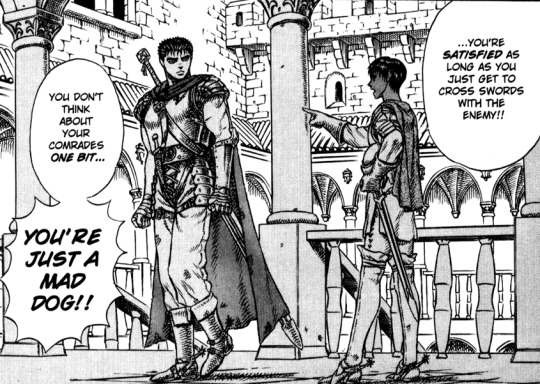

5. I really love early Casca. Honestly, the main thing that keeps me from being wholly on board with Guts/Casca as a romance is the awful effect it had on her characterization as she slipped from being a full character into being The Girl. I do think her relationship with Guts was more interesting when they were foils, but I’m not necessarily against foils -> friends -> lovers as a concept for a romance, it’s just that I feel like her personality disappeared.
Anyway, here she’s mostly a vehicle for exposition I guess - she lets the readers in on the dynamic that’s been formed over the past few years, and ultimately brings ou the old Guts in new Guts... but the fact that it’s an accusation that he doesn’t care about his teammates that brings the wild dog back out in him is, in itself, evidence of how much he’s changed.


The pre-Promrose relationship between these two is a bit difficult to pin - they’re obviously close, but I’m not wholly sure whether Guts actually realizes how close they are. By which I mean obviously he and Griffith seem to be hanging out a lot - everyone knows Guts is Griffith’s favorite, no one’s really shocked that Griffith acts like a lunatic where he’s concerned even if Casca’s the only one with a near-complete understanding of why... but Guts himself is always a little “.....” about the way Griffith is with him. The little nostalgic blushy smile, for example, or later on the Zodd situation. I would say the assassination of Julius kind of highlights the difference between the way Griffith sees their relationship and the way Guts does, because even if Guts knows Griffith cares about him by that point he still looks to Griffith as a leader - someone he has to look up at - whereas Griffith has long since started seeing him as a peer, which is why he asks Guts to go after Julius instead of ordering him.
Anyway that scene above makes me think about the film version - the one that took place on like a grassy hill for some reason. I DON’T KNOW WHY? The dialogue from Griffith is also changed in the OVA from “Even that part of you is part of my plan” to something to the effect of “fight for me, guts!” which is not nearly as character-revealing.


6. I just think it’s hilarious how literally everyone knows Griffith is weird about Guts except Guts himself. It’s like:
Rickert: Zodd! He’s immortal! He’s like a battlefield god! No one can stop him!
Judeau: Man if Guts runs into that guy he’s just going to change in like a crazy person.
Everyone: STARES AT GRIFFITH FOR SIGNS OF A NERVOUS BREAKDOWN.
Also someone send Zodd some pants.
Anyway, Zodd’s complete one-sided curbstomp of Guts is fantastic because it ends up emphasizing how much Guts’ abilities will advance by the BSM arc where he’s out there killing apostles on the regular. But ... even then it’s never easy,


Pretty sure this is the first time (chronologically speaking) that we see Guts in mortal terror. Even against the wolves he was just like, well i guess it’s time to go.
Honestly I don’t think any of the adaptations fully captured the horror of these scene - and in the OVA i was deeply distracted by Zodd not moving his mouth. But just imagining going into this fortress and finding all those corpses and then turning a corner and there’s a goddamn gigantic cat-minotaur thing curbstomping Guts of all people - it is genuinely horrifying.
But now I’m going to talk about how silly the Griffith is a sociopath thing is again. Putting aside that literally everyone knows Griffith is prone to short circuiting when Guts is in a bad situation, we also have

Griffith knows this situation is incredibly dangerous. He knows that his people can’t handle this and he seems to know they cant handle it even if he’s with them. He also knows Guts, his most important person, is in danger. What does he do? Does he throw his followers under the bus as distractions so he can go and grab Guts and leave? Does he weigh Guts vs his dream, realize that even if Guts is his strongest soldier, if he himself dies obviously the dream will never happen? No. He sends his people to safety (because... he cares about them and doesn’t want them to die needlessly?) and then throws his own self into the mouth of danger rather than leave Guts there to die.
And look at Casca. She’s doing that face - the face Guts made when the wolves came in. The face of someone staring down their horrible fate.
For Griffith, leaving Guts there to die is just not even an option - it doesn’t ping his radar, and everyone knew it wouldn’t that’s why they were all staring at him when they realized Guts is probably in danger.
Long story short, if Griffith cared about his dream more than he cared about Guts, he would have left Guts there to die instead of risking his own life, knowing the dream would die with him. And if he didn’t care about anyone except Guts and himself, then the obvious choice would have been to sacrifice the team and escape with Guts. But instead he does the foolhardy thing - also notably the thing that Guts would do, the thing Griffith recognized in Guts from day one (gambling his life on impossible odds, all while fighting to survive), and puts his own neck on the line.
Just saying.
Also, if you want to think about the implications on how Griffith feels about Guts...
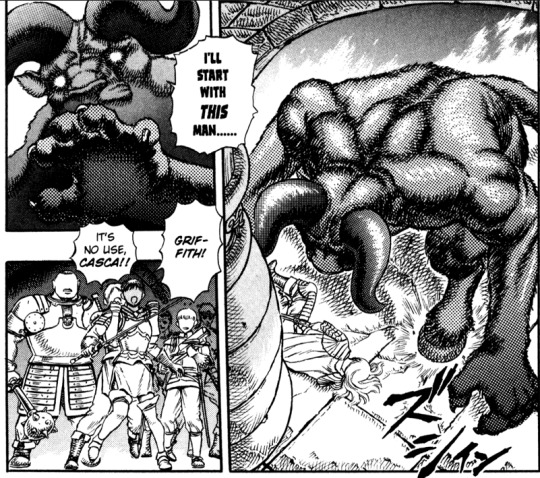
Notice that Casca, who we all know loves Griffith, has to be physically stopped from doing the same thing. This isn’t the only time there’s overlap between the way Casca and Guts react to Griffith - there’s also a lot of overlap in how Guts reacts to Griffith and the way he later reacts to Casca... but more on that as we go.

Zodd’s relationship with the Godhand is also pretty interesting - his deference to and respect for them stands out even comparative to other Apostles. And of course, this does make sense because his respect goes ot the strongest, and who is stronger than them? Pretty much just IoE I suppose.


Notably he also immediately recognizes Guts as the, I guess, primary sacrifice. Because he is obviously, given Griffith’s behavior right in front of his eyes, the person Griffith loves most.

It’s interesting because in this moment it seems like she just means if Guts weren’t so reckless, Griffith wouldn’t have gone in there after him and gotten his ass kicked by a monster. But in retrospect, she really means something more like... “if you hadn’t made Griffith irrational and emotional and weak, he wouldn’t get into these situations.”

7. Whenever I see these meetings between Griffith and nobles and such I think of them kind of... treating him like a tool, right? And that is kind of the problem he has just... in general - people who don’t relate to him as a person. He’s a tool or a symbol, a messiah... Guts is the only one who sees him as a friend/human being really, and that’s about to get blown up too. So here he is navigating court, knowing that some nobles just see him as some kind of novelty - oh look at the commoner who can act like an aristocrat! - and some see him as dangerous (and are actively plotting his demise), and some see him as their ride ot success... and meanwhile there’s the Band of the Hawk, who loves him but as an abstraction more than anything else (Casca aside. Kind of.) Just seems a bit lonely, doesn’t it?
And of course he’s also in mid-transition, changing from a commoner to a nobleman and also in many ways from a soldier to a politician. The latter being the thing that really costs him the duel later. And while the Hawks mourn for their drifting connection with him, they at least have each other whereas he’s increasingly isolated.
Anyway.
8. I see the Guts and Griffith and Casca dynamic referred to as a love triangle - Guts wants Casca, Casca wants Griffith, Griffith wants Guts - but I don’t actually think that is technically true. Because Guts really doesn’t want Casca - he thinks she’s crazy and won’t get off his back and it’s pissing him off. I guess some people read that as sublimated attraction but

To me, he really does just seem incredibly pissed off and probably... hurt that she’s constantly accusing him of not caring about people and ruining Griffith’s life and such when he does care about people, and he cares a lot about Griffith.
Eventually their feelings do start turning to one another obviously, but it kind of happens at the same time? Upfront I’ll say if it’s a love triangle, it’s much closer to a “which of two suitors will the center point choose?” style triangle than an “everyone loves the wrong person” style triangle... and the center point is Griffith, not Casca or Guts at this time. It moves to Guts later on, appropriately when the epic hero baton is passed from Griffith to Guts as well.


9. Interesting to note that Griffith doesn’t even like nobles.
The point of why Griffith wants to be a King so bad does get discussed from time to time - I think it’s a number of things, really. It’s the desire ot see how far he can push himself and what he can acquire and accomplish yes - the chase for the sacred junk so to speak. But I do also think he wants to restructure the way society works as far as hereditary power, gender roles, etc. The fact that he never says it outright isn’t especially important because you see it in action - he accepts everyone who wants to go with him, regardless of ethnicity, sex, age, and he brings out the best in his people and then gives them the titles and responsibilities they deserve regardless of those things as well. Even the incarnated Griffith later in the series does this, and adds taming the apostles and making them true citizens of society to the mix.
It’s a good dream, though its effect on him is uh, questionable, and realistically it probably wasn’t going to happen regardless because that King was never going to let Charlotte go.
...honestly, I do wonder if, had Guts not left and triggered Griffith’s mental breakdown, he would have ended up assassinating the King so that Charlotte could choose her own husband.
I mean, probably.


Goes back to the Berserkian notion that Gods, Demons, Angels, and spirits are all sort of the same thing in different types. Thus the Godhand are both Archangels and Demon Kings.






10. I could really just write a ship manifesto about these two.
This shojo scene is the closest Griffith is able to get to admitting the depth of his feelings for Guts... until the meeting on the Hill of Swords when he presents it as a past tense. The idea that yes Griffith is always going to prioritize him and there’s no specific or functional reason for it, no purpose being served and it’s just how he feels... that’s the heart of that relationship, for good and for ill.
And again, it’s directly addressing the argument that it’s about Guts’ value as a soldier, which is why... I keep saying this and keep banging my head on this wall... that interpretation is just obviously wrong. Because Guts straight up asks and calls him on his “you’re good in a fight idk idk” reasoning and Griffith doesn’t defend it or double down on it even hes just like, “Well... I’m just going to do it, I do not know what to tell you. It is what it is, my friend!” And what it is... is that he would literally rather get himself killed than lose Guts.
So. You know.
There’s that.
11. It’s wild thinking about where the King goes from this scene though. He seems so calm and measured and reasonable. I would say this is intentional though... because the thing is, the King is mostly there as a proxy through which we can understand Griffith, as he never talks about his own thoughts or feelings. So we start them in the same place - a calm, composed person of fair mind who believes in forging a more egalitarian society, but with a lot of baggage and dysfunction teeming underneath the surface.

The first meeting of Griffith and Charlotte is also portrayed in a very romancey way for obvious reasons. And it’s appropriate really because throughout most of the story Charlotte is living in a different story than everyone else, specifically a romance novel. And Griffith does kind of construct that story for her, with... interesting results.
As a sidenote, Julius is ridiculous like he smacks Griffith for keeping Charlotte from falling over? What was he supposed to do, let her break her neck tumbling down the stairs? Pfft.
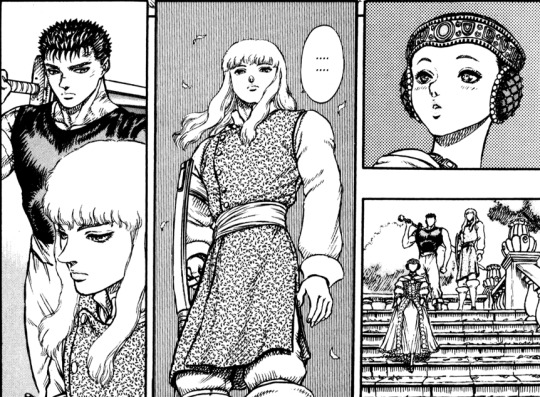
That is the look of a Griffith forming calculations, my guys.

12. Foss looks so much like a monster egg that if I didnt know he’s still around later I would legit think he’s a Godhand pawn like the fortune teller Griffith got his benefit from to begin with.
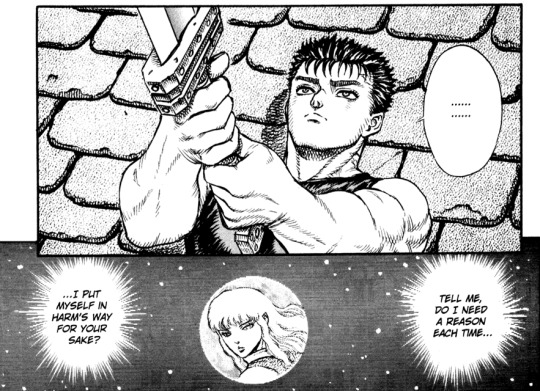
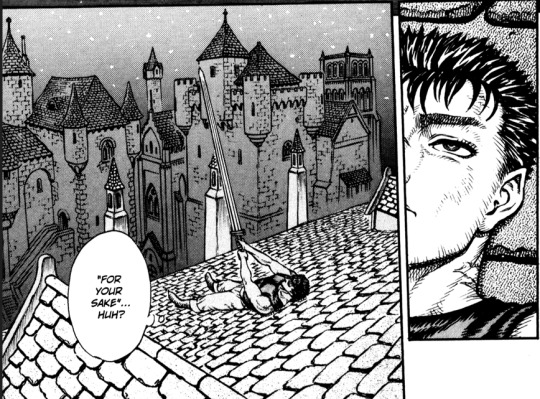



13. Guts really reminds me of those people who say they’re going to take a job just for now and they keep saying that literally until they retire 30 years later. It’s just interesting that it took him 3 years to decide that he’d commit himself to Griffith’s cause “for now.” That’s not much different than what you said three years ago, Guts!
The comparison between the night he fled from his first merc band and this night is interesting - the night he left the only home he knew, and the night that he chose to consider this place - or, really, this person - to be his new home. Guts does have a hard time seeing his own value - that’s the only reason he would still be surprised, three years on, that Griffith would and will go out of his way for him. It seems appropriate that Griffith’s saying that wha the does is just for Guts’ sake would spur Guts to decide to fight for Griffith’s sake as well.
It’s quite.
...romantic, really. Sad sad.
Now my brain is frying and I almost lost this whole thing in a pasting accident so I’m quitting while I’m ahead.
18 notes
·
View notes
Text
Finished reading Crécy by Warren Ellis
Fun comic, certainly hits that historical fiction itch, but god damn dude we get it you’re English. Now I’m not one to scoff at francophobia, and I understand the narrator isn’t completely reliable, but the comic *really* comes off with way too much of an English bias, portraying the Hundred Year’s War as Englishmen rising up against the constant threat of French invaders like they hadn’t been invading each other back and forth for centuries. It does briefly mention the Plantagenet holdings in the continent, but makes them out to be of no import when at points they covered half of France. I do like the narrative of Crécy marking a shift from medieval to early modern warfare, from cavalry focus to infantry (although this was also happening elsewhere, it wasn’t an English invention), but it focuses too much on modern national identities. The story shouldn’t have been the Cool English vs the Bastard French, it should be a story about peasant infantry pressed into service in the egotistical Capetian-Plantagenet rivalry and managing to survive against the odds. Fuck the King, both sides
1 note
·
View note
Text
Aug '23 Refine Review

Oh boy, this is nice. Link to my theorycraft
Seliph is crazy. He now gets TD = Atk 15%, Null C-Disrupt and heals 8 HP per hit, meaning 16, 24, or 32 Hp healed in combat, assuming his At War's End II triggers, and the foe doesn't die to the first hit. He got the Miracle I predicted, but only on enemy phase, when he's in 3 tiles of an ally, and is above 50% HP. With the new healing, he needs to hit the foe three times to loop miracle, but it doesn't matter, cuz he is restricted to doing so once per turn. Thankful, you don't need to trigger it more than once, since he has 80% DR vs Mages/Staff, and 40% vs the rest (Excluding AoE specials). This DR is conditional on if he initiates or there is a foe in 3 tiles. If he get him to 4 or more HP, and then he just needs to tap twice to get above 50% HP, or if he's on 12 or more, the one counterattack is fine.
Freyja definitely got an update, but will it be enough, now that we have 3 new goats running a muck? As I mentioned in my theorycraft, Freyja has both DC for enemy phase, the old beast transformation in player phase, and [Dodge] and a Foe Buff stealer effect in both phase. This mix phase form of spd tanking would be good on an infantry, but not a gen 4 calvary, and obviously, all the conditions were solo condition. She's now getting the Special CD-1 and NFU like I predicted, and the new Cavalry Beast Transformation effect like everyone predicted. She's also getting [Canto (Rem. +1)] since her B slot is taken by her perf skill. She can now reach 58% damage reduction with her weapon, and 74% when including Spd Smoke's effect. So, is all of this enough to make her top tier? Probably not. For the role she is playing as a jack-of-all-trades combat light mythic hero, she does well, but that role doesn't get you put on the team. I didn't even mention her lack of supportive abilities that mythic live and die on. All Freyja as is a counter to Buffed up foes, something any cavalry beast can do thanks to Arcane Nihility. I really think, due to DC in her weapon, she can't be a killer queen, nor an unkillable tank. Oh well, she's going to be fine.
Spring Est is something else. She has the supportive ability to apply Def/Res-6 and [Exposure] on nearest foes and foes within 2 spaces of those foes, which gives her and her allies 16 more damage delt. She also gets [Canto (1)], which is great for warping, guaranteed follow-up (which was better than my NFU as her speed wasn't up to snuff) and if the foe has [Penalty], the foe cannot counterattack. This is great.
Mareeta's Sword got a refine that does make her different from her two other alts. Null Guard, NFU, Lull Spd/Def, is all there, but the TD = 10% of her Spd, and the applying "Deadeye" to any Special is what makes her unique. We didn't get the brave sword I expected, but this makes her a God Sword Slayer like As!Fir.
Ced's WInds of Silesse is not the support tome I imagined. It's very much like Forsetii, but it uses [Bonuses] to get that effect. Atk/Spd+6, [Desperation], and [Sp Charge +1] is all there to make him a nuke, but the cherry on top is the penalty on foe's Spd Res equal to 20% of his Spd. Out of the box, that's -8, but at max investment, it's -10. Epic.
Echidna? What happen? You got +8 all stats, 30% DR on first hit, that transfers to TD on your next hit, then heal 7 HP after combat. You then have Unity and Sp Charge +1. Like, that's amazing, what did you do to bribe I.S.? I think Ross is jealous.
Travant got flyer effectiveness negation? I didn't think wyvern generals got that in Thracia but okay. He also get to lower foe's attack by 15% of his Def stat, so -6 to -8 Atk penalties. After that, he's just has +8 all stats with Special fighter and guaranteed follow-up. Overall, very nice.
I also want to add, we got new versions of Desperation in new banner, Desperation 4, which adds "Spd-4 on foe" and the condition of moving 2 or more spaces to initiate, and Flow Desperation, that takes Desperation 4 and add "Def-4 on foe" and Half-NFU like the other flow skills. I might as well change up my Frenzy 4 theorycraft to match the change.
Frenzy 4: Inflicts Spd/Def-4 on foe during combat. If a skill compares unit's Spd to foe or ally's Spd, treats unit's Spd as if granted +7. If unit's Spd > foe's Spd, reduces damage from attacks during combat and from area-of-effect Specials (excluding Røkkr area-of-effect Specials) by percentage = difference between stats × 5 (max 50%). At start of combat, if unit's HP ≤ 75% and unit initiates combat, or number of spaces from unit's start position to end position ≥ 2 and unit initiates combat, unit can make a follow-up attack before foe can counterattack.
Lysithia also got a new perf A-slot, which makes theorycrafting her original version's refine a lot easier. I will get to that banner . . . eventually.
0 notes
Text
14 Signs You Suck at 3000 Sages vs 30000 Afghan
In the annals of history, there are battles that transcend the boundaries of ordinary conflicts. These battles possess an aura of legend and evoke awe-inspiring tales of valor and extraordinary powers. One such legendary clash was the Epic Battle of Gokul, where 3000 sages faced off against a formidable army of 30,000 soldiers from Afghanistan. This extraordinary confrontation took place in the mystical land of Gokul, pitting ancient wisdom and mystical arts against the might of a disciplined military force.
Gokul, known for its spiritual significance, became the stage for an epic showdown. The sages, revered as masters of ancient scriptures and mystical arts, had dedicated their lives to enlightenment and the pursuit of wisdom. On the other side stood the Afghan army, battle-hardened warriors renowned for their martial prowess and tactical expertise.

As the Epic Battle of Gokul 3000 Sages VS 30000 Afghanistan Army, a clash of supernatural powers and military might ensued. The sages, drawing upon their vast knowledge and magical abilities, created protective barriers and unleashed devastating spells upon their adversaries. Their agility and supernatural prowess allowed them to evade attacks and launch precise counterstrikes, leaving the Afghan soldiers in awe.
The Afghan army, undeterred by the mystical displays before them, showcased their disciplined formations, strategic maneuvers, and advanced weaponry. Archers unleashed volleys of arrows, cavalry charged with thunderous might, and infantry pressed forward with unwavering determination.
The battleground became a spectacle of unparalleled forces. Spells collided with each other, arrows rained down like a dark cloud, and clashes of swords reverberated through the air. The sages, with their profound understanding of mystical arts, exhibited feats of strength and resilience that defied mortal limits.
The sages' collective energy resonated, culminating in a cataclysmic spell that unleashed the raw power of elemental forces. The Afghan soldiers, overwhelmed and disoriented, found themselves scattered amidst the chaos. Yet, their sheer numbers and unwavering resolve kept the battle raging.
#BattleOfGokul#SagesVsAfghanistanArmy#DivinePower#SpiritualMight#SupernaturalClash#WarfareVsWisdom#PowerOfRighteousness#LegendaryBattle#GokulMystics#EpicShowdown#MythicalConfrontation#ForcesOfNature#TriumphOfGoodness#SpiritualWarriors#UnyieldingDetermination#LegendsLiveOn#GokulSaga#SagesOfPower#AfghanistanArmyChallenge#MythicalRealm
0 notes
Text
Sengoku rance ran route

For example, a tactician with 8 INT will provide 8-random stat bonuses (across all units) of +40% upon the start of combat. Tacticians: Provides an (INT) number of (INT x 5)% boosts to random stats.Can initially only fire from the front-column vs the enemy's front column, they do get a piercing shot eventually with 50% damage to one row (both the front and back column). However, most Musketeers can only fire once per battle, while there are (rare) heroes who can fire twice. Their first shot is extremely fast and extremely powerful, the most powerful JAPAN attack (although weaker than the foreigner Cannons / Tulips). The more troops the Ninja has, the better the chance of instant-kill). May get "Assassinate" skills for a ~50% chance to instant-kill foes (dependent on the relative army sizes. Ninja shuriken also cancel "preparation" moves (primarily Onmyouji's AOE attack). However, Ninja are much more expensive than other units. Typically strikes first and has very low cooldown. They can attack from either back-or-front column, against the back-or-front column of the opponent. Archers Tied (with Sohei) as the 2nd cheapest unit in the game to recruit.They can only attack from the front column vs the enemy's front column however. Samurai One of the premier attacking units in the game.First at 120%, then at 80% chance of blocking, and finally 40% chance of blocking) For example, a 6-INT Ashigaru will Ally Guard at 120% (which will last for 3-hits. They can "Ally Guard", creating a INT% x2 chance of defending an ally within their column. Ashigaru (Japanese Infantry / Spearmen): Cheapest units to recruit and replace.While an army of size 2000 will only deal 200% the damage of an army size 500. In effect, an army with size 1000 will deal only 150% the damage of an army of size 500. The "Adjusted Troop Size" grows at 50% rate after 500 troops, and only grows 25% rate after 1000 troops. However, instead of scaling all the way to 9999, there is a quirk in the calculation. ), which means an army with troop count 300 will do 2x damage (and take 1/2 damage) from an army with 150. Battles on a field have a 10% advantage towards the defender, while battles in a castle start with a 90% advantage towards the defender.Īrmy battles follow roughly Lanchester's laws: ( Losing troops will reduce your advantage, while killing enemy troops will raise your advantage. The goal of combat is to achieve more than 50% "Advantage". For example, Rance's magical slave Sill will heal Rance after every action. Although unique units, such as Rance, have unique attacks and skills. Every unit has a set of skills, largely determined by their class. As a fictional setting, this includes Texas, Morraco, and South Africa (some territories of JAPAN that don't match up to the real world Japan).īattles take place in a 2x3 vs 2x3 region. With only 5 commanders (and only a few hundred soldiers per commander), Rance (the main character of Alicesoft's long running series) sets off to conquest all of JAPAN (roughly 31 territories). The game starts in Oda Nobunaga's home territory of Owari. There are also a few "foreigner" classes from the Rance main series: Mages, Cannoneers, and Knights. There are a large number of classes: such as Ashigaru (Japanese Infantry / Spearmen), Samurai, Musketeers, Sohei, Archers, Ninja, Tacticians, Onmyouji, Cavalry, and Miko. Sengoku Rance is a hentai Strategy-RPG that takes place in the fictional world of JAPAN.

0 notes
Text
Total war shogun 2 collection vs gold

#TOTAL WAR SHOGUN 2 COLLECTION VS GOLD PATCH#
#TOTAL WAR SHOGUN 2 COLLECTION VS GOLD SERIES#
Sword unit charge bonus upgrades reduced.
Sword unit melee attack skill upgrades reduced.
Admiral Heavy Bune Fire arrow ability added.
Siege Tower Bune: cost from 1550 to 3000.
Matchlock Samurai: cost from 700 to 650.
Naginata Warrior Monk Hero: cost from 1700 to 1500.
Fire Bomb Throwers: cost from 700 to 600.
Daiyku Samurai : cost from 1000 to 1100.
Matchlock Ashigaru: cost from 400 to 500.
Bow Warrior Monks: cost from 1000 to 1100.
Loan Sword Ashigaru: cost from 400 to 500.
World Weary: accuracy debuff reduced from -5 to -3, melee attack debuff reduced from -2 to -1.
Yagyu Sword Instructor: sword infantry melee attack bonus reduced from +2 to +1.
Drill Square: sword infantry melee defence bonus reduced from +3 to +2.
Trading Post: cost decrease for all units reduced from -5% to -4%.
Untrained Fugu Cook : Effect now applies to sword infantry only.
Yabusami Master: avatar accuracy and reload speed increased from +5/+5 to +7/+7.
Zori Tori Sandal-Bearer: avatar fatigue resistance increased.
Lightweight Gunjingura War Saddle: cavalry speed buff increased from +5% to +10%.
Uma-Jirushi Nobori Standard-Bearer: avatar morale buff increased from +2 to +3.
Mouldy Feed Stocks: enemy cavalry fatigue resistance debuff increased.
Kacchu-Mochi Armour-Bearer: avatar armour increased from +3 to +4.
Supply Wagon: missile units’ extra ammo increased from +5 to +8.
Scroll of Inspirational verse: avatar melee attack increased from +3 to +4.
Gokamon Bodyguard: avatar melee defence increased from +5 to +6.
Camp Sickness: missile units’ speed debuff increased.
Tetsu-Bishi Caltrops: spear and missile units’ bonus vs cav increased from +3 to +4.
The amount of XP awarded is double the base win/loss XP for avatar battles.
Avatars now get awarded XP if the player participates in a drop-in battle.
All non-key building maps have been removed from the match-making map pool.
The Kyoto and Buatsui castle maps have been removed from match-making map pool.
The small funds bracket has been removed from match-made siege battles.
Time limit added to siege battles (45 mins).
This is based on the skill tree with the most skill points spent within it. Ladder and overall stats have been rearranged for clarification and ease of use.Īn avatar’s primary skill-set is now displayed on the avatar’s banner in battles.
Units and retainers which cannot be used in the next battle have been made more visible.
Locked icons have been added to retainer slots which currently can’t be used.
The player’s current number of clan tokens is now displayed on the skills tree.
Avatar rank is now shown on the pre-battle setup screen of all users.
The XP bar on the avatar screen now shows current and required XP for a rank increase.
Match-made battles will now prioritise avatar level when attempting to match players, taking into account ELO rating.
Higher-Prestige avatars require consequently more XP to level, and cost more to field.
Upon promotion to a new Prestige level, Avatars gain +10 Veteran Slots.
Upon promotion to a new Prestige level, the avatar’s skill-tree is reset, but his units retain their veterancy, and he retains any armour pieces, retainers earned through armour pieces and clan tokens.
Coloured ranking stars are now used to define the current Prestige of an avatar: Bronze Silver and Gold.
Upon reaching level 10, Avatars can now be promoted to a new Prestige level and re-play the avatar conquest mode.
Winner of clan competition (Mon, Crest, Helmet).
#TOTAL WAR SHOGUN 2 COLLECTION VS GOLD SERIES#
There is now a series of rewards for players whose clans are promoted: Filters have been added to sort retainers into smaller concise lists based on units and weapon restrictions.You can now cycle through and view all other worlds in the clan competition as well as search for a specific clan and view the world they are operating in.A number of filters have been added to help display the strategic situations of your own and other clans in the clan competition.Points loss: Every time a player loses a match-made battle, they will lose 50% of the clan influence they would have gained for a victory.Corruption and logistics: clans will suffer a cumulative 5% cost in influence point gain for every province beyond 3 that they own (with a maximum penalty of 95%).These maps do not appear in the Rise of The Samurai DLC campaign. O 1 top-tier castle, considerably larger than any other castle in Shogun 2Įach castle appears across five maps, resulting in 15 new siege battle-map variants. O 1 standard sized castle on a clifftop with limited approaches O 1 standard sized castle of new configuration Three newly-designed castles specifically for the Shogun 2 campaign map:
#TOTAL WAR SHOGUN 2 COLLECTION VS GOLD PATCH#
Darüber hinaus steht ein Patch mit allerlei Bugfixes und Balance-Verbesserungen für das Hauptprogramm bereit und sollte automatisch runtergeladen werden.

0 notes
Text
Game of Kings:The Blood Throne

Warrior Kings, it’s time to build your empire and seize the throne of a medieval kingdom rife with magic and turmoil!
Game of Kings: The Blood Throne is a free to play real-time strategy and simulation war game for mobile where players build armies, slay and cultivate monsters, form alliances, and battle each other to achieve their destinies and take their seat upon the Blood Throne!
With the weave of magic unraveling, the ancient and mysterious Rune Continent of legend has appeared! Not for the faint of heart, the Rune Continent brings untold challenges and rewards for those brave enough to enter. Gather your Alliance and test your spirit amidst the mayhem of the battlefield, as you stand shoulder to shoulder to conquer the Rune Wonder in intense warfare against players from all servers! Who will best all rivals and claim the title of Supreme King?
Game of Kings Features:
✔ Epic Player vs. Player Strategic Warfare
Real-time PvP combat against from players around the world. Hone your strategy to outsmart your enemies and lay siege to their settlements!
✔ Unique Monster System
Goblins and Skeletons and Dragons, oh my! Explore the world map to hunt and slay monsters. Unlock and cultivate monsters in your Beastiary to bolster the ranks of your army and dominate the battlefield!
✔ Build a Massive Army
Train infantry, ranged, cavalry and siege units across four increasingly powerful tiers! Amass hundreds of thousands of soldiers to conquer and defend your empire!
✔ Resource Management
Gather, produce, and manage six different resources (food, iron, stone, wood, silver, and gold) to build and upgrade your Stronghold, train your armies, and research new technologies!
✔ Cooperative Alliances
Create or join an Alliances to team up and wage war across the kingdom. Make friends with players from around the world, develop and strategize together, and rally your forces to triumph over all others!
✔ Academic Research
Over 140 different technologies can be researched in your Academy to give your kingdom an edge over your opponents and enhance your capabilities in War, Defense, Trade, Economy, Tactics and Construction.
✔ Customize Your Heroes
Forge legendary weapons and armor to equip your Heroes and become immensely powerful! Develop your Heroes across two different skill trees to best suit your plans for victory!
✔ Real-time Chat Translation
No language barriers! Talk and cooperate with anyone with our real-time chat translation system, capable of providing translation for 34 different languages!
NOTE: Game of Kings: The Blood Throne is completely free to download and free to play; however, in-app purchases for some items can be made with real money within the game. If you don’t wish to use this feature, please disable this function for your device or in the in-game settings.
Join us on Facebook: https://www.facebook.com/GameOfKings.TheBloodThrone
Read the full article
0 notes
Text
British 1803 Pattern Sword
The 1803 Pattern Sword for Officers of the Grenadiers and Light Companies is the fifth pattern to be officially recognised by the British army since it began specifying what swords were to be carried by the officers and enlisted men.
It is, in my opinion one of the more attractive swords to have come out of the British Army of the Georgian era. With it’s distinctive lion’s head pommel, the gilded royal cypher in the slot guard, to the curved blade that with it’s rich blue and gilt decoration. No two 1803s are ever the same, making the Pattern a rewarding sword to collect.

Officially adopted in 1803, the pattern is likely a modification of a regimental type that was already in use with some officers of the Grenadiers and Light Companies. Its adoption coincides with newly formed Light Infantry regiments that were formed on the success of the 95th Rifles and the French Chasseurs a Pied.
Officers of these units saw themselves as leaders of elite troops and sought to distinguish themselves with different uniforms and equipment. This included a preference for curved sabres rather than straight swords and several adopted their own specific regimental pattern sabre that was unique to that unit.
While it can be argued that the type of combat these units engaged in, close quarter skirmishes over broken ground favoured a short sabre as less encumbering and better suited for brawling like, slashing attacks. The importance of establishing an ‘esprit de corps’ and following fashion trends of the day should not be overlooked.

The 1803 Pattern itself, is a shift away from the previous 1796 and 1798 patterns, that both described the hilt and blade specifications, in that it only covered the hilt, and the blade was to be curved. The exact length of the blade and the amount of curvature was left up to the individual taste of the officer. As a result, there is a significant amount of variation in the blade profile of surviving examples. Some have a practical curve of five or so centimetres and look like scaled down cavalry sabres. While others sport wildly curved, un-fullered blades that mimic the ever-fashionable Mameluke shamshir swords. And the blade length varies from as short as sixty-eight centimetres all the way up to a cavalry length eighty-one centimetres.
Typically, the blades would have been blue and gilt with engraving of the GR cypher for George III, the British Coat of arms and other martial motifs.


Even though the hilt was the pattern, here too there is considerable variation. The grip is most commonly found with leather or shagreen (shark skin) over a wooden core with twisted silver wire in the groves. But ivory and occasionally just twisted wire were also used, according to the officers’ preference, financial means and what his superior officer permitted. The pommel could either be a half or full lions head of differing quality. While very rarely the GR cypher was replaced with a fouled anchor indication naval service, a family or regimental crest. On the knuckle guard, above the crowned GR some swords also have the grenadiers flaming bomb or Light Company / Infantry hunters bugle emblem.
These three swords from different sword cutlers illustrate some of these differences.
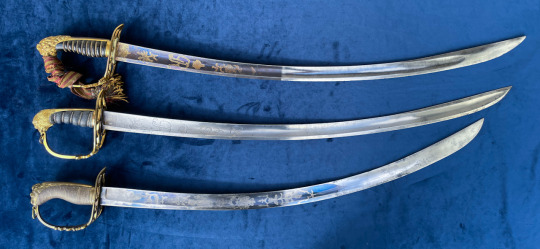
The two with the J J Runkel blades are longer, both over 80cm and have less curvature. They give the impression of being more ‘combat’ ready than the third by Griffin & Adams which is 76cm long and has a 73cm curve (vs 51cm of the Runkel blades). Two have a broad flat tip while the other has the fuller all the way to the tip of the blade, presumably to give it a sturdier point.
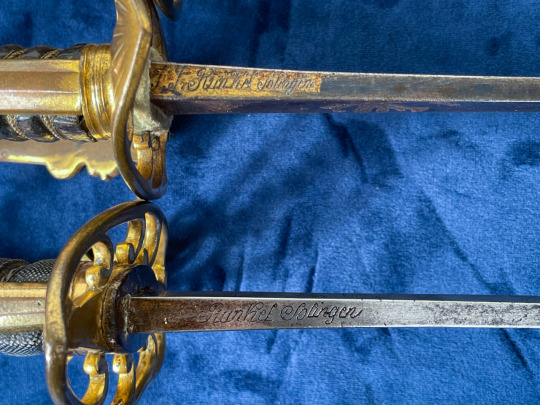
From top down:
Light Company Officers sabre by Bennet circa 1803 – 1810
J J Runkel imported Solingen blade
Typical Solingen blade detailing
Leather covered grip with gilt or copper wire
Detailed full lions head pommel
Slot in the knuckle guard for the sword knot
Strung Bugle Light Company emblem pinned to the guard above the Royal Cypher
Solid, prominent GR Cypher
Scabbard throat locket marked ‘Bennett 67 Royal Exchange’ on the reverse

1803 Pattern Officers Sabre by Prosser circa 1804
J J Runkel imported blade
Shagreen grip with silver wire
Early style, full lion head pommel.
Typical Solingen style blade engraving
Pommel ring for the sword knot
Pierced GR Cypher
Scabbard throat marked ‘Prosser Charing Cross London’ on the reverse and owners’ initials, WWB on the front.

Light Company Officers Sabre by Griffin & Adams.
Blade devoid of makers’ mark
Twisted wire bound grip
Detailed half lions head pommel
Typical British engraving, included ‘Warranted’ in a banner, an infantry officer armed with a sabre and other patriotic themes
Pommel ring for sword knot
Light Company strung bugle incorporated into the casting.
Partially pierced GR Cypher
Scabbard locket marked ‘Griffin & Adams Sword Cutlers to H.R.H the Duke of Clarence ~ 76 ~ Strand on the reverse

#sword#Sabre#Antique#Georgian#1803 Pattern Officers Sabre#Flank Officers#Light Company#Grenadier Company#British Army#napoleonic wars
111 notes
·
View notes
Text
Clash of FE Classes Opening Round - Match 2

(pictured: a Cavalier icon from Shadow Dragon, a Knight icon from Shadow Dragon, and a generic Great Knight portrait from Three Houses, on a GBAFE arena background)
introductions to the classes, other closely associated classes, and explanations under the cut
Cavaliers are typically horse-riding units who wield swords as well as lances, and promote into Paladins. in some games, Cavaliers are only given one type of weapon, and divide into classes according to those weapon types, usually (but not always) remaining single-weapon even after promotion. no matter the weapon, though, Cavaliers stand out for their versatility, high movement, and balanced stats, with Paladins often being among the few physical melee classes with more than below average Resistance. Alfred from Engage plays very similar to a Cavalier while belonging to a pair of Lord-unique classes.
(NOTE: Refer to Match 7 for Bow Knights, etc.)
Armor Knights are typically heavy-armored, lance-wielding infantry units, who promote into Generals, thusly picking up at least one and sometimes several new weapons. in some games, Knights are instead given one of various types of weapon, and divide into classes according to these weapon types; however, even in such games, it's typical for the divided classes to eventually all promote their way into the same final class, which combines all of its potential predecessors' weapon proficiencies. Knights are infamous for their extreme stat spreads, with abysmal Speed but outstanding Defense and HP; they're difficult to take down, although they'll generally find themselves vulnerable against magic, effective-damage weapons, or just a sufficiently strong and persistent axe user. Knights and Generals are also extraordinarily common as enemy bosses, especially in the early- to mid-game; being formidable, but with discrete weaknesses, they naturally test a fledgeling player's ability to adapt to challenges. closely associated classes include the Baron from Gaiden/Echoes: Shadows of Valentia, Genealogy of the Holy War and Thracia 776; the Marshall from Radiant Dawn; the Fortress Knight from Three Houses; the Spartan from Echoes: Shadows of Valentia; and the monstrous Fiend from Gaiden/Echoes: Shadows of Valentia. Hector from Blazing Blade and Edelgard from Three Houses play very similarly to Armor Knights while belonging to various Lord-unique classes.
Great Knights are staples of Fire Emblem games with flexible promotion options, typically acting as a common option for Cavaliers as well as Knights. heavily armored cavalry is a traditional image of medieval warfare, and Great Knights seal it in deeper than the likes of Paladins; they tend to compromise between mobility and toughness in a way that makes them very distinct from other classes, at least at a glance. Great Knights are typically afforded a broad range of weapon proficiencies by their middle-road promotion status, but they usually end up being associated with axes first of all.
3 notes
·
View notes
Photo

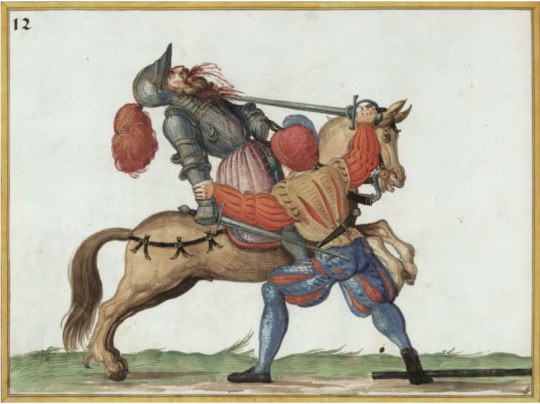
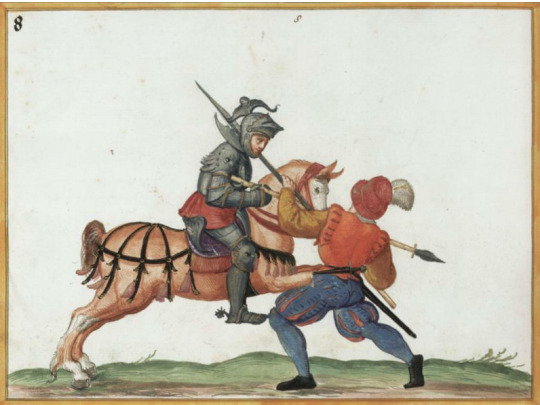
Infantry vs Cavalry situations and techniques
(images for attention)
May be relevant to students of history or historical fencing or those looking into writing/creating various sorts of art be it books or video games or imagery or to those standing up to police brutality in the modern age(albeit applicability to that aspect is lessened due to a different context from when the historical manuscripts and manuals were written).
Obviously historically in many cases these types of situations weren’t 1 on 1 dueling type situations but rather parts of a larger group fight-be it a skirmish with at least several or more folks up to a pitched battle in this or that era.
The exact tactics and strategy changed a lot over time but when actually facing a mounted fighter there are some general rules for an infantry fighter to lean on and vice versa.
A lot of it is about quickly deflecting and countering the cavalry attack, sometimes attacking the rider, sometimes the horse.
The images in that link are specfically from the works of Paulus Hector Mair which you can find in the ‘‘Mounted fencing’‘ section of the page devoted to him.
As are the two images headlining this post which you can find here and here and here.
The descriptions are as follows:
“[13] Yet another way of throwing the rider to the ground.If you are on horse, and you see the footman has armed himself with rapier and buckler, then spur your horse and ride swiftly toward him with sword drawn and the point aimed toward the opponent's face or chest. If you see your opponent ride at you in this manner, then remove his thrust with the long edge to your left and drop both rapier and buckler and run toward the opponent, grab hold with the left hand on the outside of his right arm, and the inside of his elbow, and pull down, and at the same time you grab hold with your right hand in the left side of his neck, and you will throw him to the ground without risk of injury.“
“[12] A way for the footman to throw the rider off the saddle.If you are mounted and you see your opponent footman using rapier, then draw your sword as well, and ride toward him and strike toward his head. If your opponent does this very thing, you lift up your rapier and remove his strike to the left with the long edge. Then you step forward as fast a you can with to his right side, and grab hold with your left hand in his right hand and push him away in this manner, and thus he will not be able to fight against you. Then you pierce his neck with your rapier as hard as you can, and in this manner the horseman will fall.“
”[8] A device where the rider has a spear and the foot-soldier has a halberd.When riding toward your opponent, do as follows: Hold the spear extended over your right leg in your right hand, and when you are about to attack, you insert the spear in the arret, and ride toward him thus. If your opponent comes at you in said manner, then step forward with your left foot and hold your halberd in a strike from above, and strike his spear away from left to your right side, and you have averted his attack. Then you take two steps toward him and hook him in the left side of his neck with the head of the halberd and pull forcefully to you, and you will throw the rider off his horse.”
Here’s a few more later era examples that feature sabers and lances.
1 on 1 infantry sometimes actually has the advantage-manouvering a horse is something that takes a lot of skill and while horses absolutely can get accustomed to a lot and have historically participated in battles,even effectively attacking on their own not just being transport they generally speaking cannot outmanouvre an infantry fighter easily 1 on 1.
They can outrun one and a cavalry force may sometimes more easily outmanouver an infantry force because it’s faster but the ability to turn in place in a controlled manner is lesser.
While still dangerous any cavalry force loses a lot of its potential for causing harm when not able to actually charge.
A horse that is standing can still kick,trample and even bite-albeit the likelyhood of that happening depends a lot on the horse and its training-it may happen because the animal is scared but it may happen if the animal is trained to do so(as many horses used for the military were historically).
However a horse that was scared enough in one situation is unlikely to want to ever participate in such a thing again, this doesn’t necessarily require actual harm or pain to the horse-if they are unacustomed to it sometimes even loud enough sound is enough.
Also depends on what weapons is the rider using-is it a lance,a spear,a straight or curved sword or saber-do they also have a shield,or are they maybe throwing javelins,or shooting arrows from bows or crossbows?
Or like in the 20th century a rifle or pistol sometimes alongside a saber.
Or as in modern times do they have batons?
Even a lance can be used effectively very close range even when standing-even if it’s hard to thrust many cavalry manuals show effective use of it for hitting with like a quaterstaff from horseback in a way,albeit often one handed.
It may make control harder but it can still hit with a lot of power.
Bows,crossbows,rifles obviously aren’t too advantageous at close range-not that they can’t be used but are still dangerous.
Sword and sabers and batons function fairly similarly in that the mounted fighter generally tries to land strong hits from above,likely being able to reach the head most easily without much necessary focus on accuracy.
Generally infantry if there’s more of it can ‘‘always’‘ ‘‘simply’‘ swarm cavalry and unhorse the riders,but that only applies if the horse is standing in place or moving slowly-the faster the horse goes the harder it is to accomplish this as infantry,unless one is using a pike or similar-which can be very effective.
The obvious issue is the above noted horses ability to kick,trample and bite as well as the fact that the rider can still hit.
Just as with combat generally being good at using proper timing,footwork and distance management can accomplish much.
One may close in and wrestle the rider of the horse(as noted above),to dismount them(sometimes in order to mount their horse immediately after,but unlike in movies without proper training that’s not really as easily doable-especially being able to control the horse especially if said horse had a connection to that rider).
One can do so by getting one or both of the riders legs out of the stirrups,or by pulling their reins(which requires care as to not pull the horse towards you or your infantry partners) and then pulling the rider down.
There’s also a fair bit of wrestling one can do on horseback and variants of that can be applied from the ground as well.Here’s a video of some horse wrestling that’s still done in Kyrgyzstan
As seen in the images above some of these techniques may be applied unarmed while others work only with weapons,while some can be more easily done if one can use a weapon or something else as a lever to pull someone off the horse.
Here’s a video of police showing how one can remain in control of their horse if attacked-and an infantry fighter would basically want to prevent the mounted fighter from being able to do any of it.
One could also theoretically “just” ‘lasso’ a rider and pull them down.
For more examples on the general topic it may be worth checking out these few posts, going through the treatise database and looking for cavalry manuals that may show more details as well as joining Horsy HEMA and the blog tag relating to it.
If the wrestling bit of the mentioned techniques sounds more interesting
Ringen discussiongroup! is a good place to check out if you’re interested in historical wrestling variants, as are HEMA Grapplers and Scholars of Fiore dei Liberi.
The first group focuses on ringen, the second is about more general historical wrestling types,the third on armizare, the wrestling portion of which is called abrazare.
If you’re interested in learning about historical forms of boxing or as it was often called pugilism check out HEMA pugilists
If you are interested in more modern forms of unarmed combat do check out Southpaw’s Mixed Marxist Arts Club
Good luck everyone.
And stay safe
And if you can consider donating to any of these causes.
Consider getting this rashguard
We need change and justice for all.
This may be a useful link as well.
For anyone unclear on this Black Lives Matter.
#swords#sword#historical fencing#hema#mounted combat#cavalry#cavalry vs infantry#BLM#Black Lives Matter
72 notes
·
View notes
Text
[This refers to the Battle of Heilsberg. From the Memoirs of General Saint-Chamans]
La division de cavalerie légère du général Lasalle ayant été mise au même instant dans la déroute la plus complète, ce général n'eut que le temps, pour ne pas être pris, de se jeter dans un carré d'infanterie formé par un bataillon du 105 régiment; Murat et le maréchal Soult s'y trouvaient déjà, car la déroute de notre cavalerie avait été si prompte que chacun s'était jeté où il avait pu : ce carré était débordé par la cava lerie russe qui le cernait de tous côtés; il fit cependant sa retraite en bon ordre et sans être entamé, repoussant par un feu bien nourri toutes les charges de cavalerie qui se présen tèrent; si les Russes avaient su quels prisonniers ils pouvaient y faire, ils l'auraient sans doute enfoncé en sacrifiant quelque cavalerie (1).
(1) On m'a assuré que, quelques jours avant cette affaire, Murat et le maréchal Soult avaient eu une discussion assez vive sur la prééminence à accorder en campagne à la cavalerie sur l'infanterie, ou à cette dernière sur la cavalerie : Murat tenait pour la cavalerie, et le maréchal pour l'in fanterie ; quand ils furent enfermés dans le carré du 105e, d'où l'on voyait la plaine couverte de notre cavalerie en déroute, tandis que ces 500 hommes d'infanterie se retiraient en bon ordre au milieu de 10,000 cavaliers russes, le maréchal demanda à Murat, en lui rappelant leur discussion, ce qu'il en pensait. J'ignore ce que ce dernier répondit, mais ce que je sais fort bien, par un de mes camarades qui étaient près de lui, c'est qu'il criait à chaque instant aux soldats avec son accent gascon: « Tenez bon, mes amis, c'est le cas! » (Note de l'auteur.)
Le soir du combat d'Heilsberg, Murat, reconnaissant que l'infanterie avait triomphé de la cavalerie et se considérant ainsi comme vaincu, envoya au maréchal Soult le sabre qu'il avait porté durant la journée.
* * * * *
General Lasalle's light cavalry division having been put in the most complete rout at the same time, this general had only time, so as not to be caught, to throw himself into an infantry square formed by a battalion of the 105 regiment; Murat and Marshal Soult were already there, for the rout of our cavalry had been so prompt that everyone had thrown himself where he could: this square was overflowed by the Russian cavalry which surrounded it on all sides; he retired, however, in good order and without being pursued(?), repelling by a well-fed fire all the cavalry charges which presented themselves; if the Russians had known which prisoners they could take there, they would undoubtedly have driven it in by sacrificing some cavalry (1).
(1) I have been assured that, a few days before this affair, Murat and Marshal Soult had had a fairly lively discussion on the pre-eminence to be granted in the field to the cavalry over the infantry, or to the latter over the cavalry: Murat held for the cavalry, and the marshal for the infantry; when they were shut up in the 105th square, from where we could see the covered plain of our routed cavalry, while these 500 infantrymen withdrew in good order amid 10,000 Russian horsemen, the marshal asked Murat, reminding him of their discussion, what he thought about it. I do not know what the latter replied, but what I know very well, from one of my comrades who were near him, was that he was constantly shouting to the soldiers with his Gascon accent: "Hold on, my friends, I say!” (Author's note.)
On the evening of the Heilsberg fight, Murat, recognizing that the infantry had triumphed over the cavalry and thus considering himself as defeated, sent Marshal Soult the saber he had worn during the day.
5 notes
·
View notes